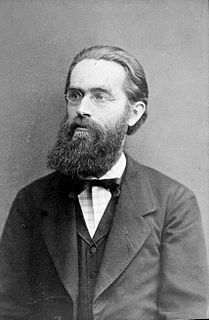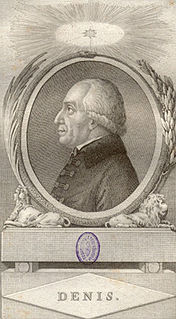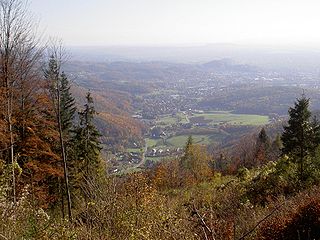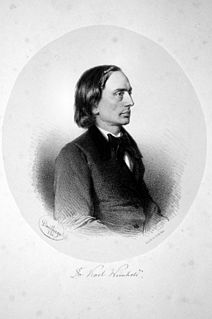
Minnesang was a tradition of lyric- and song-writing in Germany that flourished in the Middle High German period. This period of medieval German literature began in the 12th century and continued into the 14th. People who wrote and performed Minnesang were known as Minnesänger, and a single song was called a Minnelied.

Caspar Rudolph Ritter von Jhering was a German jurist. He is best known for his 1872 book Der Kampf ums Recht, as a legal scholar, and as the founder of a modern sociological and historical school of law.

Walther von der Vogelweide was a Minnesänger, who composed and performed love-songs and political songs ("Sprüche") in Middle High German. Walther has been described as greatest German lyrical poet before Goethe; his hundred or so love-songs are widely regarded as the pinnacle of Minnesang, the medieval German love lyric, and his innovations breathed new life into the tradition of courtly love. He is also the first political poet writing in German, with a considerable body of encomium, satire, invective, and moralising.

Johannes Thiele, full name Karl Hermann Johannes Thiele was a German zoologist specialized in malacology. Thiele was born in Goldap, East Prussia. His Handbuch der systematischen Weichtierkunde is a standard work. From 1904 until his retirement in 1925 he was the curator of the malacological collection at the Museum für Naturkunde in Berlin. Thiele described more than 1.500 new species of molluscs; until today their types are deposited with the Museum of Natural History in Berlin. Especially important are his works on the Mollusca of the First German Antarctica Expedition and of the German Deep Sea Expedition aboard the vessel Valdivia.

Wilhelm Karl Ritter von Haidinger was an Austrian mineralogist.

Julius Ferdinand von Hann was an Austrian meteorologist. He is seen as a father of modern meteorology.

Josef Breuer was a distinguished physician who made key discoveries in neurophysiology, and whose work in the 1880s with his patient Bertha Pappenheim, known as Anna O., developed the talking cure and laid the foundation to psychoanalysis as developed by his protégé Sigmund Freud.

Johann Nepomuk Cosmas Michael Denis, also: Sined the Bard, was an Austrian Catholic priest and Jesuit, who is best known as a poet, bibliographer, and lepidopterist.

Dietmar von Aist was a Minnesinger from a baronial family in the Duchy of Austria, whose work is representative of the lyric poetry in the Danube region.

Eduard von Martens also known as Carl or Karl Eduard von Martens, was a German zoologist.

The Lords of Thannhausen are an old and still existing German noble family with the rank of Freiherr (Baron). They were members of the German nobility and achieved the status of Imperial Knights. Their ancestral seat is in the Swabian municipality of Tannhausen near Ellwangen.
Herman Rudolf Günsberg (1827–1879) was a chemist originating in Pidkamin, near Brody who distinguished himself by his fostering of the economic development of Galicia.
Lambert Schmithausen is a retired professor of Buddhist Studies, having served in positions at the University of Munster and the University of Hamburg (Germany). He is one of the leading academics in the field.

Hugo Iltis was a Czech-American biologist.
Vitslav III (1265/8–1325), variously called Vislav, Vizlav, Wislaw, Wizlaw and Witslaw in English sources, was the last Slavic ruler of the Danish Principality of Rugia. He is often identified with the author of the Minnesinger Vitslav of the Jenaer Liederhandschrift.

Rudolf Kner was an Austrian zoologist and ichthyologist.
Hermann von Wissmann was a German-Austrian explorer of Arabia.

Reinmar von Brennenberg was a minnesinger and ministerialis to the Bishop of Regensburg in the 13th century.

Schloss Rohrau is a castle in the town of Rohrau in Lower Austria, bordering on Burgenland. The building houses the art collection of the counts of Harrach.



















